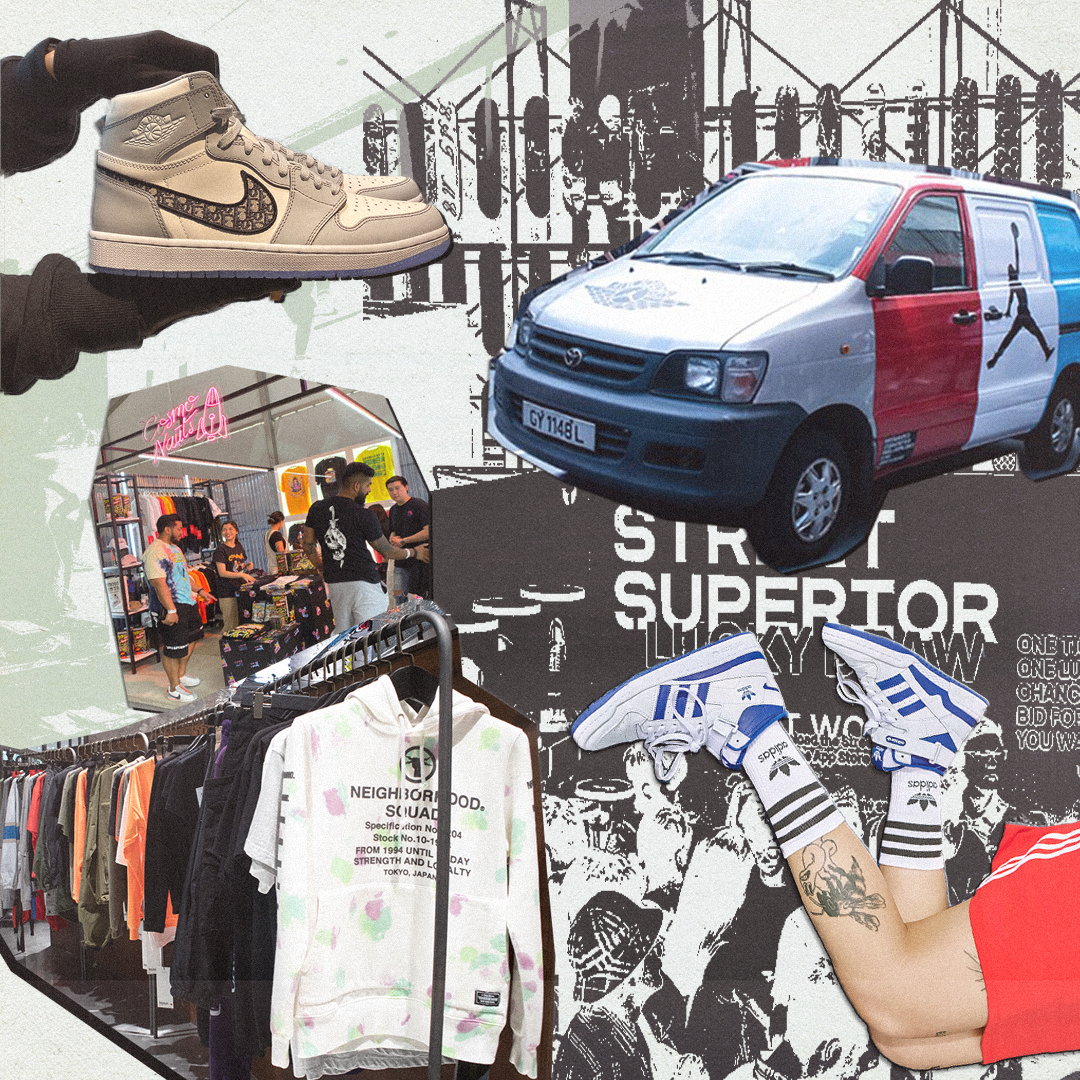Sign up for trending news and first dibs
Custom Kings: 5 Experts You Must Know
Custom Kings: 5 Experts You Must Know
Whether it is due to a true appreciation of quality, or the desire to stand out, customized goods are hot property. We speak to five customizers who are at the forefront of their craft. Read on!
By Daniel Loy
Jacob Ferrato (JBF Customs)
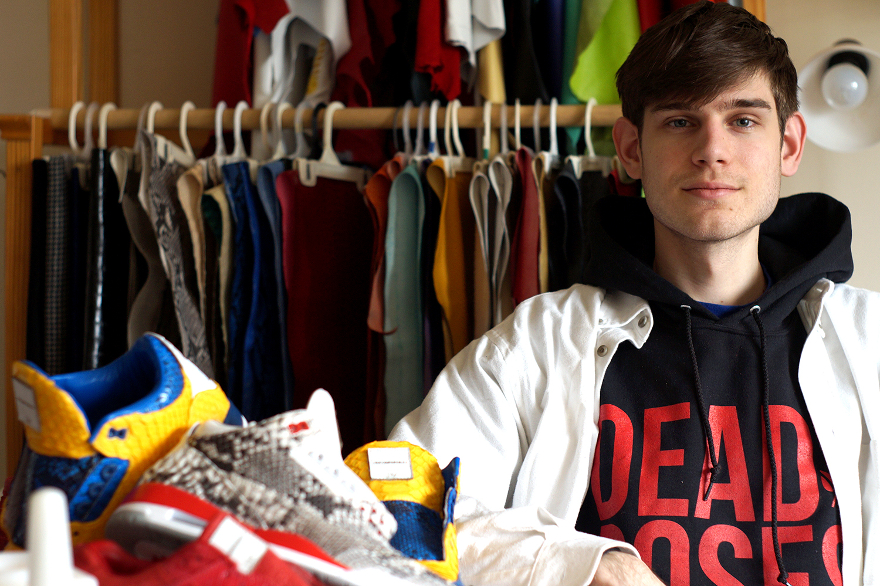
Jacob Ferrato, the wunderkind of custom kicks
If you’re into customized sneakers, you would’ve heard of JBF Customs. But who exactly is behind stunning customs such as the Python Air Jordan 1 “Bred”? Meet 22-year-old Jacob Ferrato, the wunderkind who’s been customizing sneakers since he was 16 and has gained a cult following. Though he’s based in the United States, Ferrato’s clients hail from all over the world.
Taking shoes apart, applying modifications and stitching them back together is all in a day’s work for Ferrato, who’s currently working on more than eight pairs of sneakers. Be prepared to shell out US$1,000 and up for a pair of customized kicks – the more exotic the leather, the more you pay. We find out more from the man himself.

Python Jordan 1 “Bred”
Hi Jacob! What got you into sneaker customization?
I wear a size 14 and could never get the shoes I wanted in my size, so I decided to make myself some.
What inspires you?
I get most of my inspiration from nature and its phenomenons. I have to admit I don’t look at as much design work as I probably should.
Most of your work utilizes different textures, especially snakeskin. Why the fascination with the reptilian skin?
It’s really just a fascination with texture. The python is what I am often commissioned to do right now, and I’m sure that will change someday – but there will always be a focus on the perfect blending of textures.
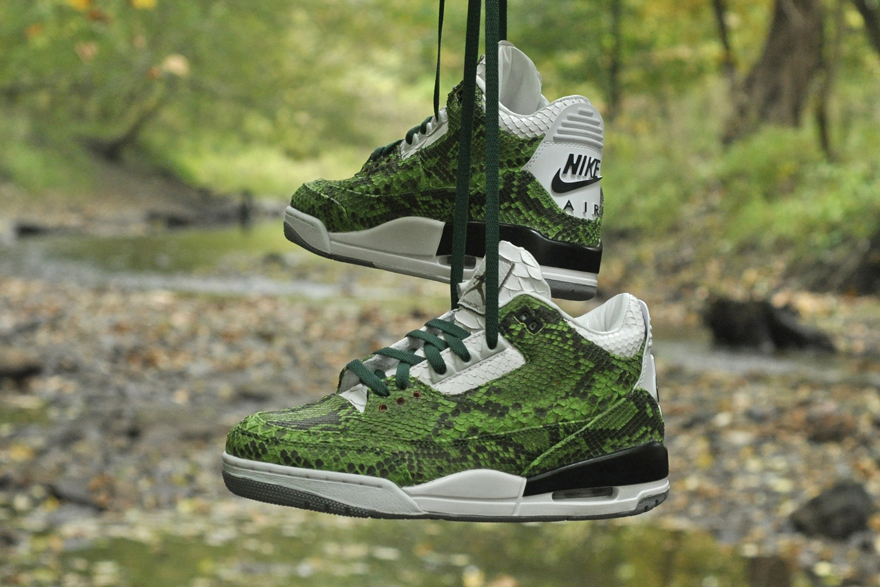
Green Python Jordan 3s
What’s your favorite sneaker silhouette to work on?
That’s tough – I think the Jordan 1 is one of the best sneaker silhouettes ever, but I also really like Nike Blazer SBs, Dunks, and adidas shell-toes.
Ever had thoughts of creating your own, never-seen-before sneaker silhouette?
In due time – it’s a hell of a process to bring that to fruition.
What’s the biggest challenge you’ve encountered to date?
Probably managing to run the customization business while being a full time college student last year. I’ve since graduated, thank God.
Follow Jacob Ferrato (@JBFcustoms) on Instagram and Twitter, and visit JBFcustoms for more of his custom work.
Images courtesy of JBF Customs
Hozen (Maestro Guitars)
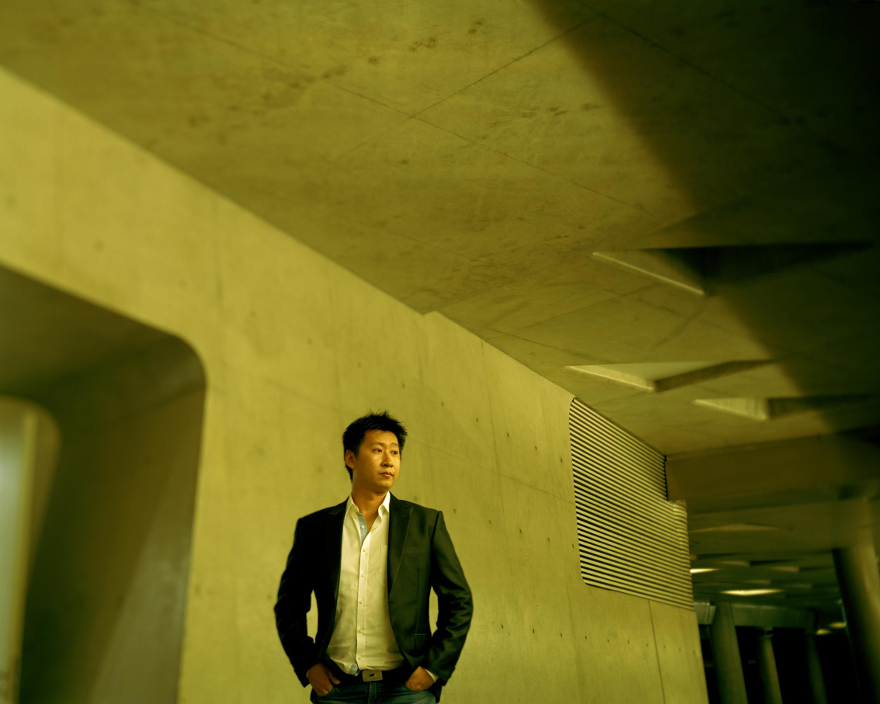
Hozen of Maestro Guitars
Anyone can buy a guitar, but not anyone can make one, so we’ve got a lot of respect for Hozen, a 34-year-old luthier (maker of string instruments) who has been in the business of perfecting and selling guitars for a decade.
Hozen makes ukuleles, classical and acoustic guitars to suit a musician’s needs, and these handcrafted instruments are sold through his brand Maestro. Production is done in China, but wait – before you freak out – Hozen makes monthly trips there to ensure that every guitar produced is top-notch. Maestro guitars cost anything from S$500 to S$8,000, and have been used by several indie artists including singer-songwriter Shimona Kee and Malaysian composer Az Samad. We speak to Hozen about his love for all things string.

Hozen working on the guitar’s internal bracing
Hello Hozen, where did your passion for guitars come from?
I was influenced by my dad, who owns Renner Piano, a music instrument retailer and service center. I was helping out at his shop doing guitar repairs and soon began dabbling in guitar kits, building guitars myself. In 2002, I went to Music China, a yearly guitar convention, and that’s when I saw quality, solid-top guitars. I negotiated with the makers and started by assembling pre-fabricated parts like the guitar body and neck in Singapore.
Your business model underwent a major change in 2010. What happened?
In 2010, I realized I couldn’t call myself a guitar builder if I were only assembling in Singapore pre-fabricated kits from China. It was getting harder to find dedicated staff in Singapore, which led to inconsistent quality. I also had no control over how the Chinese counterparts manufactured the components and consequently, the whole work process.
In the end, I made a very crazy decision to close down the workshop here and move to Guangzhou, China. I hired experienced staff and spent two years changing their mindset from quantity-driven to quality-driven. That said, I’m still in charge of designing every guitar in our range and critical components like the sourcing of wood and tuning the guitar soundboard. Because of this, I can only make about 50 guitars per month.
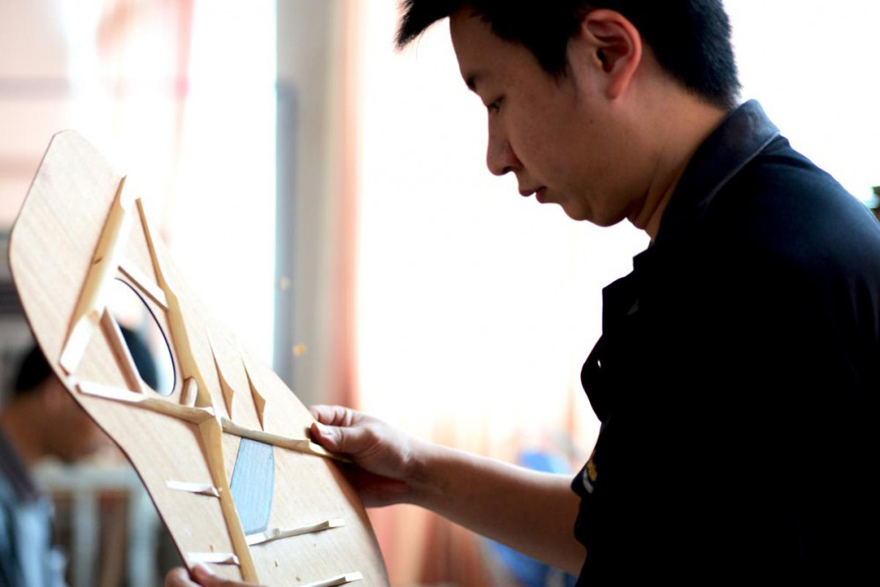
Inspecting the work
What goes on in the Singapore workshop then?
We do the final quality control here. I recently got the Plek machine that costs over S$150,000. It gives a consistent guitar set-up, so the guitar can be played comfortably without any buzzing. But the workshop here still has the capability, in terms of tools and material, to build guitars.
What separates a custom guitar from one that’s mass-produced?
A custom guitar is unique, and made for a specific customer. We customize aspects such as the playability, the nut width – anything you want, from the playing experience to the specific tonality to the outlook of the instrument. It’s the same reason why one gets a tailor-made suit instead of an off-the-shelf suit.
When potential customers come, we sit them through the entire process, explaining to them what they are in for. We help them to understand the tonal subtleties between the different choices they make. After going through a custom-building program with us, they know more about guitars.

The workshop in Singapore caters to quality control but can double up as a production workshop
How long should customers expect to wait for their custom guitar to be made?
It takes about 90 to 120 days, depending on the availability of the wood as well. We stock easily 10 to 20 different types of tone woods, giving customers a variety to choose from.
It hasn’t been an easy journey, what’s the biggest challenge you’ve faced to date?
I think it’s still people’s reception towards Asian-built instruments. People are skeptical and don’t see that it’s the process that matters, not the country of origin. I don’t really blame them, because the assumption tends to be that China-made products are bad.
Would you say you’ve perfected the art of guitar making, or is there room for improvement?
There’s always room for improvement and so many things to learn everyday, even through constant exchange of information with other guitar builders. We strive to be the best, so it’s a constant race, bearing in mind that as Asian builders, if we’re not the best, people will sidestep us.
Maestro Guitars can be found at several dealers islandwide. Click here for the various locations.
Images courtesy of Maestro Guitars
Soh Jin Kheng (310 Woodland)
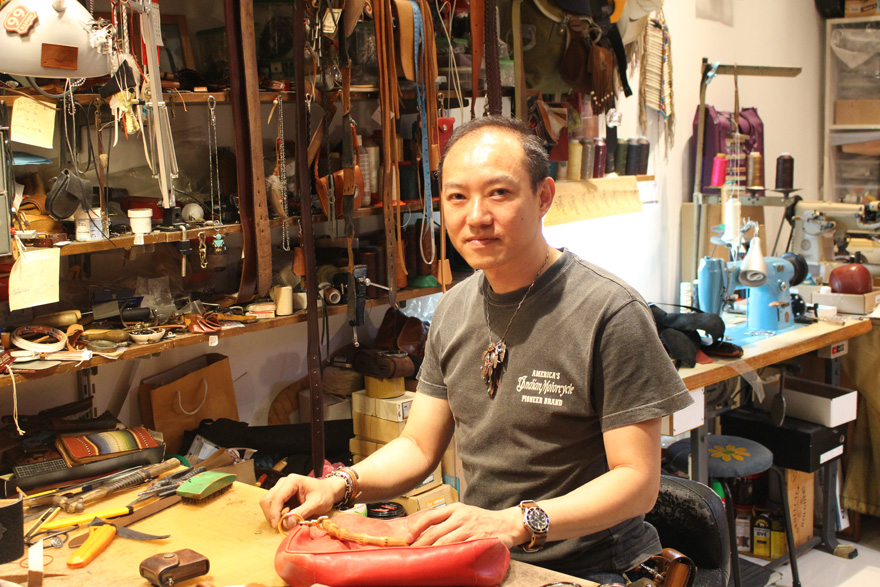
Uncle Soh and his workspace
Those with discerning taste have no qualms shelling top dollar for bespoke leather goods, so who would’ve thought something so luxe and trendy first found its footing in Singapore through leather goods pioneer, the humble Soh Jin Kheng, also affectionately known as Uncle Soh? The 47-year-old owner of 310 Woodland has been crafting leather products for over 20 years. Wallets, key pouches, bags, even re-purposed ammo pouches, Uncle Soh has made them all. Prices start from S$10 for small items all the way to S$4,000 for crocodile skin bags.
When The Heeren shut its doors for a major revamp back in 2012, 310 Woodland made Orchard Central its home. Leather products occupy almost every inch of the shop space, and the back of the shop is the workspace where Uncle Soh practices his craft. These days, he also conducts leather crafting classes. We took the opportunity to sit in on one.
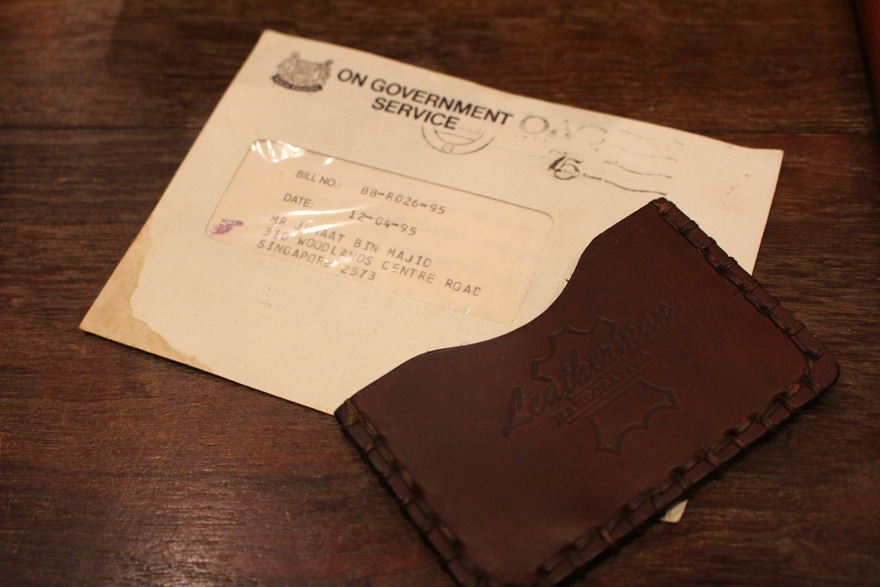
Uncle Soh was first inspired to make leather products by a guy who manned a kiosk called “Leatherman”
Thanks for having us, Uncle Soh. How did you get into leather customization?
I’ve always liked leather and was inspired in my younger days by a guy who made leather products under the brand “Leatherman”. His kiosk was situated at the current Concorde Hotel and later on at Wisma Atria’s Isetan. After National Service, I was still hung up on the idea of making leather products. One day, in 1991, I passed by a shop at 310 Woodlands Centre Road and saw some guys making leather products there. I got to know one of them, Jumaat, and joined their team.
How was business like back then?
People got to know about us, and those from pasar malams (night markets) bought in bulk from us to sell there. We supplied them first, without getting any money beforehand. The money came in slowly, but we had no choice. We realized it wasn’t going to work in the long term. During one of the visits to get our money, we saw that sales were very good. We started renting our own stalls to sell our products. We did this for quite a few years.
How did you eventually find your way to The Heeren?
There’s a field next to Faber House, near The Heeren. We used to have a yearly night market there. Back then, The Heeren was being built, and I saw an ad for shop rentals. My wife enquired and we managed to get a shop space there. Thinking back, selling at night markets was tough. We had to contend with the weather and were always on the move. Having a shop is so much easier.

Every inch of available space is used to display leather goods
What about your partner, Jumaat?
Back then, he frequented Indonesia and wanted to set up a factory there, so I had no choice but to continue the business alone, from Heeren till now. Jumaat is now back in Singapore and I’m still in contact with him. In fact, some items in my shop are made by him.
Why choose leather instead of other materials?
I was attracted by leather all those years ago. Leather is very durable, and it can be made into almost anything you want. To me, it’s also fun making all these products. I like Native American-inspired and Western cowboy leather crafts, as you can tell from what I have in my shop. But I can also make plain, simple items. Just show me a picture or sample!
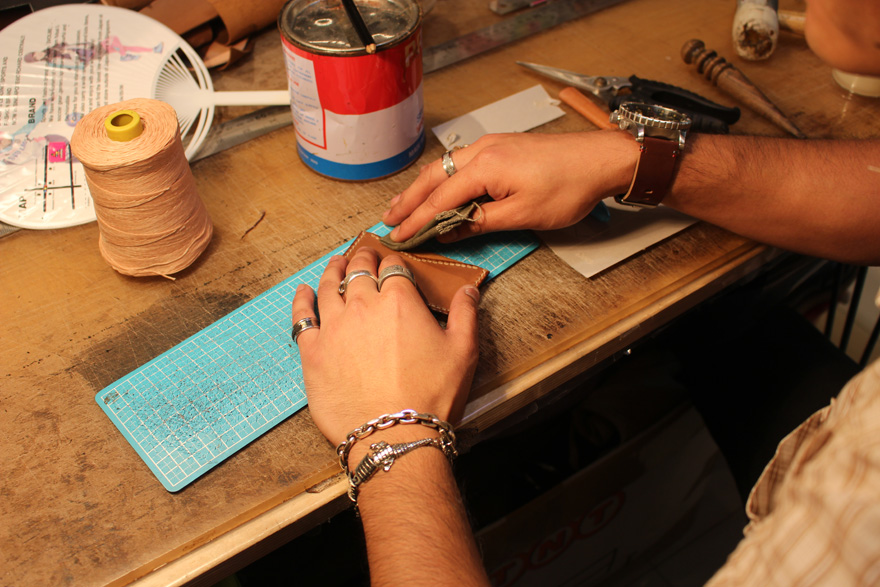
A student’s handiwork
These days, the younger guys are also venturing into leather product making. What do you think of that?
It’s good, in fact during my time back in Heeren, this trade was dying. Leather factories moved to Malaysia and China, leaving small ones behind. After some time, with no one taking over, these factories closed down. For me it’s a hobby, so I just do whatever I can. If the young people don’t continue where we left off, this trade will eventually die out.
Tell us more about your product making classes.
We teach the basics first, like how to properly cut the leather based on the size of items to be placed in the product. This is followed by rounding the corners and pasting the pieces together, before punching holes, if necessary. If you can handle these steps, the rest shouldn’t be a problem. Each one-to-one class is 2 hours and costs $100; at the end of it you would have made your own leather product.
310 Woodland is located at Orchard Central, #03-28A. Visit their website to see more of Uncle Soh’s work.
Edwin Neo (ed et al)

Edwin Neo, founder, head shoemaker and designer at ed et al
There’s a long-held assumption that a good pair of leather dress shoes would have to come from an atelier in a far-off European city. Shoemaker Edwin Neo, who started off as a shoe repairer and worked his way to becoming Singapore’s pioneer bespoke shoemaker, dispelled this myth with ed et al – his line of quality and value-for-money dress shoes.
Ed et al caters to every budget. The Ready To Wear collection (S$300) can be purchased off the shelf at their boutique or website. The Made To Order collection (prices start from S$500) gives you the preference of choice of shoe design, color and leather type. Minor details such as medallions and embellishments can also be added on for a fee.
The holy grail of all is the Bespoke service (prices start from S$2,500, which includes a one-time fee of S$1,000 for a bespoke last or a mold of your feet). The resulting Bespoke shoe is entirely handmade and constructed using the finest materials and techniques. When you return again for your next Bespoke, you will only need to foot the bill for the shoe, since the last, well, lasts.
We had a chat with Edwin to get the lowdown on bespoke shoemaking.

The ed et al flagship store at Millenia Walk feels like a step back in time to old-school shoe shops for gentlemen
Hi Edwin, share with us your journey into shoe making.
After serving in the army, I worked for my brother-in-law as a shoe repairer for six to eight years. In that time, I spent four years learning how to make shoes. At the end of those four years, I left for Budapest to apprentice under a shoemaker. Shoemaking is easy, but perfecting it is difficult. Shoe repair and shoemaking share similar tools and machinery and both professions are considered allied trades. As a shoe repairer, I had more than enough hands-on experience with tools and leather so it was much easier for me when I made the transition to becoming a shoemaker.
Prior to starting et ed al, what was missing in the local men’s shoes market?
High quality, reasonably priced shoes of a certain technique. We use techniques such as Goodyear welting, which allows you to re-sole the shoe an infinite number of times as long as the upper is in good condition. There weren’t many shoes with full leather soles and high quality calf leather uppers being sold at reasonable prices. A truly customized service was also missing.
Do bespoke leather shoes require more maintenance work from customers?
Nope. It requires more work on the shoemakers’ part. That said, customers do tend to take care of bespoke shoes more, simply because of the cost and time needed to obtain the shoes in the first place. Routine polishing every fortnight or month is sufficient.

Attention to detail is evident, even in the Ready To Wear collection
Why are bespoke shoes more desirable compared to mass-produced shoes?
There’s a certain “romance” to it. Customers come down to our shop and make their requests known to the shoemaker, who then interprets it. It becomes much more than just a transaction; it’s a relationship. In this relationship, we know what the customer wants and doesn’t want, so during the shoe making process we try to deliver what he wants. Practically speaking, choosing your own design and having a good, close fit that doesn’t deviate much makes bespoke shoes more desirable.
What’s the typical waiting time for a pair of bespoke shoes?
Anything from three to six months. It can even be longer, depending on the frequency of the customer’s visits for the fitting sessions. I have customers who are not based in Singapore who come in only every six months or so. Some of their shoes have been in progress for one and a half years.
Any plans in the pipeline?
We’re starting our accessories line within this month or the next. For a start, we’ll be selling cardholders, wallets, iPad folios – pretty standard stuff. We just launched our shoe repair service. For instance, we do shoe polishing which uses factory polishes and equipment; this ensures you get the best shine which is similar to that of a brand new shoe from the store.
Are you more of a traditional shoemaker, or have you employed modern technology to aid in some of the work?
In terms of manufacturing, yes we are traditionalists. We believe the old techniques that have been used for decades are the ones we should use. Probably the most advanced technology we have in the workshop is a laser pattern cutter. We use computer software to grade the patterns of our new shoe design to different sizes, and the laser pattern cutter will cut out the patterns. It’s much easier and faster, but everything else is done by hand.
To see ed et al’s range of Ready To Wear shoes or find out more about their Bespoke services, visit their website here.
Mervyn Augustine (Ong Radio)

Mervyn, along with an uber cool home theater setup
Music appreciation has grown in recent years, as seen from the resurgence of the vinyl format and a plethora of high-end earphones and speakers that have entered the market. Those with extra home space have even converted their spare rooms into music havens, allowing an escape from the madness of urban living. Building a high end audio system goes beyond buying a big pair of speakers, which is where experts like Mervyn Augustine from Ong Radio step in.
Started in 1937, Ong Radio has dedicated itself to customizing high end audio systems and private theaters for its clientele. From the key equipment down to the room acoustics and cable routing, Ong Radio has done it all. We listen to Mervyn as he enlightens us on all things audio.
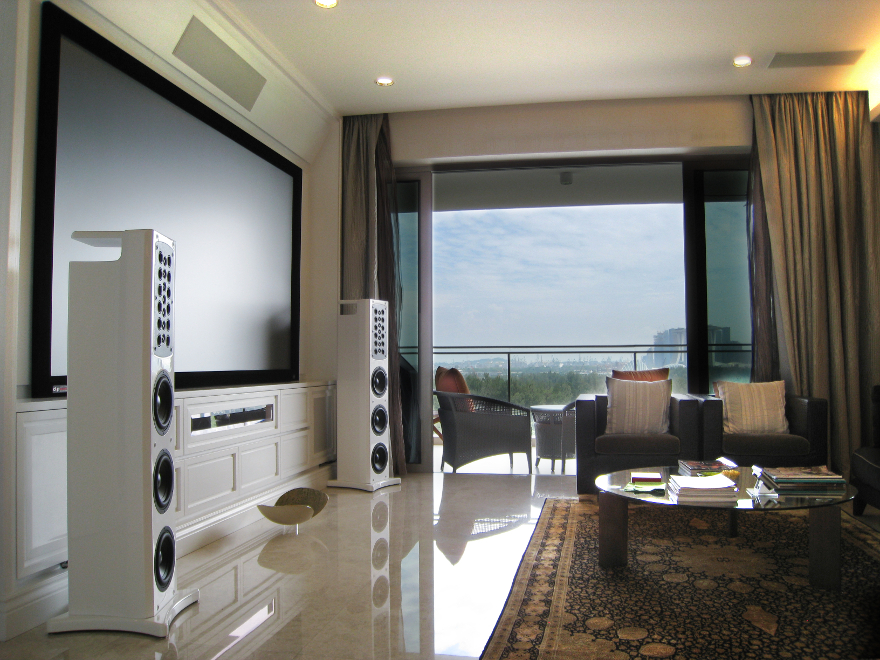
Who says giant speakers can’t complement the home?
Hi Mervyn. First off, why are people dedicating spaces in their homes purely for audio pleasure?
Music appreciation is a hobby and a rare art-science form that invokes emotions. Audiophiles spend lots of time and money and would want to enjoy their music in the best space possible. A space that is quiet, somewhat symmetrical and with little distraction. The overall system should take the listener to another place – studio, lounge or concert hall – and make them feel like being in the presence of the artist performing.
What are the approaches to a customized home audio system?
There are two trains of thought in customizing a home audio system. The first is a High-Fidelity approach, where the aim is to achieve a system (and room) response neutral in a frequency curve measuring 20Hz to 20kHz. This approach adds nothing to the mix and is akin to consuming music “as-is”.
The second is a Preferential approach, which is basically achieving sound that’s pleasing to your ears. This approach is subjective and hard to be quantified. That’s why it doesn’t work on all genres of music or all music recorded differently. Choosing the right approach makes component purchases clearer. Of course, speakers are an important factor as they are the mechanical interface to the listener. Different speakers have different sound signatures so pick one based on your approach.
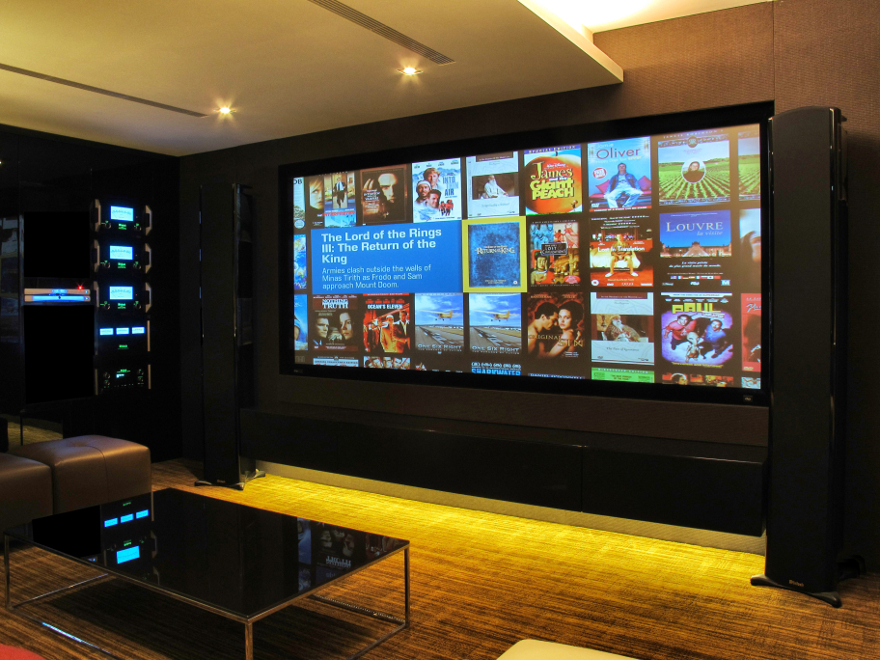
Watch theater-quality movies from the comfort of your own home
That said, what components make up a home audio system?
First of all, the system requires a source, be it a disc player, digital music player or turntable. If it’s a digital source, it will require a Digital to Analog Convertor (DAC), pre-amplifier for volume control and multiple source inputs, amplifier and lastly speakers. Some systems are simpler due to components with integrated functions. Depending on the consumer, the system can be a one-time investment or constantly upgraded. We believe that good speakers and amplifiers are the infrastructure that the rest of the system is built upon.
How has digital media changed the landscape of sound systems?
Digital media has made music enjoyment simpler and sound systems more convenient. When vinyls and cassettes were mainstream, one would have had to flip the vinyl or cassette at the end of each side to keep the music playing. The Compact Disc (CD) changed this and now that we have Cloud storage capability, music has become far more accessible than it ever was. Of course, there is a compromise in quality with smaller file sizes.
Audio systems have evolved in tandem as well. There is more emphasis on the DAC section for dedicated audio systems that takes the data from digital devices and converts them into better quality signals. DACs bridge the gap in terms of sound quality and allow you to enjoy the convenience of digital media.
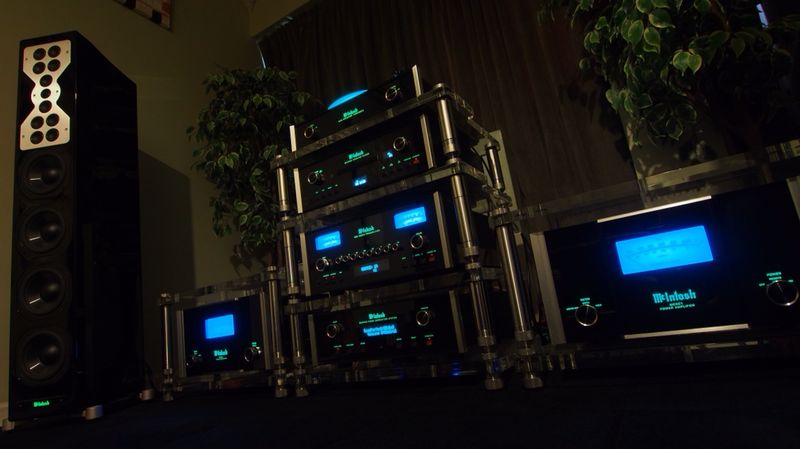
The controls look daunting but Mervyn assures us it’s not as complicated as what most people think
What lengths have some customers gone to in order to attain the best audio experience?
I’ve had customers who run an isolated power supply from the main power box into the dedicated room, bought specialized racks and equipment feet to eliminate vibration from individual components. Some have an amplifier for each section – bass, mid-range, highs of a speaker – instead of using one amplifier for all. This gives three times the refinement and power. Although these sound extraordinary to the layman, it’s actually relatively common to audiophiles.
What’s your opinion on people going back to the vintage vinyl format?
Vinyl appreciation has been on the rise a couple of years now, and a very good vinyl pressing often sounds better than a digital format. Some industry players are trying to achieve a compression-less, loss-less analog sound, and they’re getting closer to it. Good vinyl recordings surpass the CD and give higher resolution recordings. Think of it as watching a Blu-ray movie versus a DVD. Of course, the recordings must have been made with the vinyl output in mind.
Given that flat dwellers have less space compared to private homeowners, would the lack of space size affect the quality of audio that can be achieved?
It actually doesn’t! Most audio systems can be optimized for the space needed, but of course, building from scratch and customizing what goes into the audio system would be the way forward.
All systems featured above were designed and installed by Ong Radio. Visit their website or follow them on Facebook to find out more about the world of customized audio systems.
Images courtesy of Ong Radio
TAGS
Tags:


